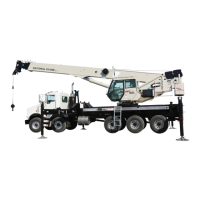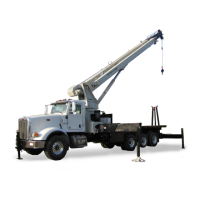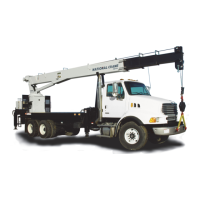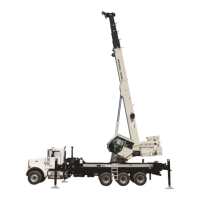CONTROLS AND OPERATING PROCEDURES OPERATOR MANUAL NBT60L
3-26 Published 09-06-2019 Control # 691-01
4. If it is not practical to fully retract the boom and place it in
the travel position, then perform the following and
proceed to Step 6:
a. Make the crane as stable as possible, including,
boom angle, superstructure orientation, jib angle,
etc. In high winds, the boom and jibs should be
lowered or secured.
b. Engage the swing brake and/or swing lock.
5. Park the crane on a stable surface.
6. Apply the parking brake.
7. Put all operating controls in the neutral position.
8. Position the Crane Function switch to OFF.
9. Shut down the engine following the proper procedures
specified in this manual and the applicable engine
manual.
10. Remove the keys.
11. Disconnect batteries if machine will be inactive for over
24 hours.
12. Close and lock all windows, covers, and doors.
Unattended Crane
The configuration in which the crane should be left while
unattended shall be determined by a qualified, designated
individual familiar with the job site, configuration, conditions,
and limitations.
Before Making the Lift
• Set the outriggers as described in the section titled
Outrigger Setup, page 4-1.
• Program the RCL. For more information, see “RCL
Setup” on page 7-8.
• Check all controls for proper operation. If any abnormal
operations are detected, the condition must be corrected
before continuing.
• Check the work area for electric power lines.
LOAD CHART
Your unit is designed to provide satisfactory service if it is not
loaded in excess of the maximum rated loads specified in the
load chart. Overloading can create safety hazards, cause
structural damage, and shorten the service life of the crane.
You must understand how to use the load charts located in
the crane cab. Make sure the load, the working area, and the
crane configuration are within the load limit specified in the
load chart.
NOTE: Load handling devices (hook blocks and slings) are
considered part of the load.
Using the Load Chart
The load chart is stored in a pocket in the crane cab. The
load chart contains lifting capacities of the crane in all
allowable lifting configurations.
The following list is a definition of terms needed when using
the load chart.
• Load Radius — The horizontal distance from the
centerline of rotation, before loading, to the center of the
vertical load line or block. This distance is slightly
greater with an unloaded boom due to deflection.
• Loaded Boom Angle — The loaded boom angle is the
angle between the first section boom and the horizontal
with the load. The loaded boom angle combined with the
boom length approximates the operating radius.
•Working Area — The area measured in a circular arc
above the center line of rotation to the suspended load.
• Freely Suspended Load — The load hanging free with
no direct external force applied except by the loadline.
• Side Load — Horizontal side force applied to the lifted
load either on the ground or in the air.
• Boom Length — The length from boom pivot pin to the
boom nose. Decals on either side of the boom shows
when specific boom lengths are reached.
• Range Diagram — The range diagram (Figure 3-19)
shows the operating radius and height of the unloaded
boom nose at all boom lengths and angles. It should be
used as a guide to position unloaded load line and to
CAUTION
To avoid possible engine fault codes and undesirable
operation, ensure the key switch has been off 2 minutes
before disconnecting batteries.
WARNING
Tipping Hazard!
Changing weather conditions including but not limited to:
wind, ice accumulation, precipitation, flooding, lightning,
etc. should be considered when determining the location
and configuration of a crane when it is to be left
unattended.
Failure to comply with these instructions may cause death
or serious injury.

